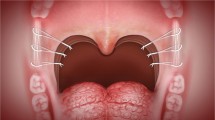Abstract
Pillar implants provide a reasonable outcome with minimal post-operative morbidity and complications in treating patients with sleep-disordered breathing (SDB) who had obvious palatal obstruction. The palatal structure is responsible for a normal functioning Eustachian tube; however, little is known if there is any potential otologic implication of minimally invasive palatal stiffening surgery for SDB. The aim of this study is to evaluate the effects of Pillar implantation on middle ear function. We performed a prospective study in a tertiary referral center. Thirty SDB patients (25 men, 5 women; mean age, 44.3 years) who underwent Pillar implants for treating palatal obstruction were enrolled. The subjects had normal otologic exam and no previous history of chronic ear disease. Pure-tone audiometry and tympanometry were performed pre-operatively, and post-operative days 1 and 7, and months 1 and 3. Baseline and post-operative middle ear pressures (MEPs) in decipascals were compared. Statistical analysis was performed by repeated measures of ANOVA. Eight patients (8/30, 26.7 %) reported otologic complaints such as ear pressure and/or otalgia within 1 week post-operatively. No permanent otologic discomfort occurred. A trend toward reduced MEP was noted in this study. The decrease in MEP became apparent on post-operative day 1 after surgery. However, mean pressure changes were no longer significantly different from pre-operative values by 1 week after surgery. Pillar implantation for SDB induces changes in middle ear function. However, the changes were temporary and not significant 1 week after surgery.
Similar content being viewed by others
References
Steward DL, Weaver EM, Woodson BT (2004) A comparison of radiofrequency treatment schemes for obstructive sleep apnea syndrome. Otolaryngol Head Neck Surg 130:579–585
Farrar J, Ryan J, Oliver E et al (2008) Radiofrequency ablation for the treatment of obstructive sleep apnea: a meta-analysis. Laryngoscope 118:1878–1883
Steward DL, Huntley TC, Woodson BT et al (2008) Palate implants for obstructive sleep apnea: multi-institution, randomized, placebo-controlled study. Otolaryngol Head Neck Surg 139:506–510
Friedman M, Schalch P, Lin HC et al (2008) Palatal implants for the treatment of snoring and obstructive sleep apnea/hypopnea syndrome. Otolaryngol Head Neck Surg 138:209–216
Nordgård S, Wormdal K, Bugten V et al (2004) Palatal implants: a new method for the treatment of snoring. Acta Otolaryngol 124:970–975
Maurer JT, Sommer JU, Hein G et al (2012) Palatal implants in the treatment of obstructive sleep apnea: a randomised, placebo-controlled single-centre trial. Eur Arch Otorhinolaryngol 269:1851–1856
Friedman M, Lin HC, Gurpinar B et al (2007) Minimally invasive single-stage multilevel treatment for obstructive sleep apnea/hypopnea syndrome. Laryngoscope 117:1859–1863
Gillespie MB, Wylie PE, Lee-Chiong T et al (2011) Effect of palatal implants on continuous positive airway pressure and compliance. Otolaryngol Head Neck Surg 144:230–236
Nordgård S, Stene BK, Skjøstad KW (2006) Soft palate implants for the treatment of mild to moderate obstructive sleep apnea. Otolaryngol Head Neck Surg 134:565–570
Saylam G, Korkmaz H, Firat H (2009) Do palatal implants really reduce snoring in long-term follow-up? Laryngoscope 119:1000–1004
Friedman M, Tanyeri H, La Rosa M et al (1999) Clinical predictors of obstructive sleep apnea. Laryngoscope 109:1901–1907
Friedman M, Soans R, Gurpinar B et al (2008) Interexaminer agreement of Friedman tongue positions for staging of obstructive sleep apnea/hypopnea syndrome. Otolaryngol Head Neck Surg 139:372–377
Rechtschaffen A, Kales A (1968) A manual of standardized terminology, techniques and scoring system for sleep stages of human subjects. Los Angeles: UCLA Brain Information Service, Brain Research Institute
Kushida CA, Littner MR, Morgenthaler T et al (2005) Practice parameters for the indications for polysomnography and related procedures: an update for 2005. Sleep 28:499–521
American Academy of Sleep Medicine (1999) Sleep-related breathing disorders in adults: recommendations for syndrome definition and measurement techniques in clinical research. The report of an American Academy of sleep medicine task force. Sleep 22:667–689
Friedman M, Vidyasagar R, Bliznikas D et al (2006) Patient selection and efficacy of Pillar implant technique for treatment of snoring and obstructive sleep apnea/hypopnea syndrome. Otolaryngol Head Neck Surg 134:187–196
Bluestone CD (2005) Eustachian tube: structure, function, role in otitis media. BC Decker Inc., Hamilton, Ontario, 41–44 and 124–125
Finkelstein Y, Talmi Y, Zohar Y et al (1987) Can uvulopalatopharyngoplasty be harmful to eustachian tube function? Acta Otolaryngol 104:511–520
Marais J, Armstrong MW (1999) Effect of laser uvulopalatoplasty on middle ear function. Laryngoscope 109:1947–1949
Lin HC, Friedman M, Chang HW et al (2011) Effects of obstructive sleep apnea surgery on middle ear function. Arch Otolaryngol Head Neck Surg 137:373–376
Barsoumian R, Kuehn DP, Moon JB, Canady JW et al (1998) An anatomic study of the tensor veli palatini and dilator tubae muscles in relation to the eustachian tube and velar function. Cleft Palate Craniofac J 35:101–110
Huang MH, Lee ST, Rajendran K (1997) A fresh cadaveric study of the paratubal muscles: implications for Eustachian tube function in cleft palate. Plast Reconstr Surg 100:833–842
Acknowledgments
The authors thank Drs. Chau-Shiang Guo, Mao-Chang Su and Yung-Che Chen for assistance in manuscript preparation.
Author information
Authors and Affiliations
Corresponding author
Rights and permissions
About this article
Cite this article
Lin, HC., Friedman, M., Chang, HW. et al. Effects of Pillar implants for sleep-related breathing disorders on middle ear function. Eur Arch Otorhinolaryngol 270, 2339–2343 (2013). https://doi.org/10.1007/s00405-013-2411-6
Received:
Accepted:
Published:
Issue Date:
DOI: https://doi.org/10.1007/s00405-013-2411-6




